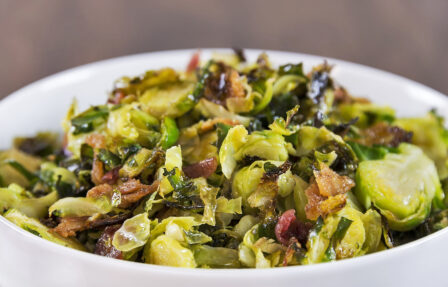Brussel Sprouts


Our beloved brussels became popular in Britain towards the end of the 1800s and gained their name after the Belgian capital. In season September to March, they are not just a Christmas veg, and often taste sweeter after the first frost in January/February! The amazing Stuart Kettell once rolled a Brussels sprout to the top of Mt. Snowdon using only his nose – try searching online for a great video of his challenge.

Nutrition
Sprouts are great for getting in your fibre and rich in vitamin C, K and folic acid. This makes brussels a great source of folate which helps to reduce tiredness and improve alertness.

Shopping Guide
Look out for a bright green colour on your sprouts that feel firm to touch. Top tip: for a sweeter sprout go for the smaller or medium sized heads.

Storage
You can keep your Brussels sprouts in the fridge for a week when kept dry and in the freezer for longer. Blanch the sprouts in boiling water for 3 mins first, then leave to cool before laying on a tray and popping in the freezer for a few hours. From here you can throw them in a storage bag or container.

Serving Suggestions
You can boil, steam, or microwave sprouts with a small amount of water, however many kids prefer them less mushy and more caramelised by stir-frying or roasting. Just toss them in some olive oil and a pinch of salt and pepper.

Seasonality
Buying veg in season is not only great for the planet, it can be good for your wallet, too! Seasonal veg are often cheaper and frequently taste better, so can be a better time to try with a child as the often sweeter, riper taste is more enjoyable.
Coming In:
August
At Its Best:
September - March

Engage
Here are some of our favourite ways to engage kids with Brussels sprouts:
Arts & Crafts
Start simple with some non-food based engagement. This is especially helpful for a fussier child or those with sensitivities around food.
For sprouts, why not try making a bowlful of playdough sprouts or drawing one up close? Pay close attention to the details – is it all one shade of green or are there different colours involved? Can you see the individual leaves? If you cut a sprout in half, can you see and draw or make the layers?

Sensory
Sensory exploration can be a wonderful introduction to physically interacting with veg. Turn it into a positive, pressure-free experience by starting off with the golden rules of “You don’t need to try and you don’t need to like.” Reassuring a child that, while they have a chance to taste a veg, they don’t have to, and are not expected to like it if they do, can make them more happy to engage with it.
Try exploring whole sprouts and halved ones with your sense of sight, describing what you see. What do they remind you of? What colours and patterns can you see? Can you come up with an imaginative or funny description for them? If you can get hold of a “sprout stick” where they are still on the stalk (greengrocers and some supermarkets sell them in the winter), see what that reminds you of, too!

Kids in the Kitchen
Children who help to prep and cook veg are more likely to eat it. If you feel your child is ready to help and could benefit from it, keep the stress and mess to a minimum by choosing one simple task for them to do as part of the prep, meaning they can be involved and feel like the recipe is in part ‘theirs’, but also not make the process too much longer or more complicated.
For a younger child, why not get them to help you peel the outer layer of leaves off so you can halve them, or toss some peeled and halved sprouts in a little oil and salt so you can roast them (the best way to bring out their sweetness and avoid mushiness from boiling them!).
For an older child, it could be a great opportunity to teach them the bridge grip for some essential knife skills. Show them how to take a whole sprout, peel the outer leaves off, then slice carefully through the middle. You could leave them halved and roast or fry in a little oil and salt, or a confident chopper could help you slice them finely to “shred” and eat raw in a slaw or fried with some butter and grated cheese!
DOWNLOAD:
Use our Kitchen Ninja chart and videos to find simple ways for kids to help in the kitchen.


Your Food
Sprouts can be a little bitter and not easy to like (especially when boiled until soft which brings out the bitterness!), but with a little effort you can make them different and exciting…
Use our simple sprout side dishes and family favourite meals that work well with sprouts to convince the sprout-skeptics in the family!
Recipes

Serving
The moments before food is offered can be a perfect opportunity for engagement that can help make it more likely a child will eat it!
The first thing to do is remove the pressure. If the veg doesn’t get eaten, it’s not the end of the world. There will be other days, other dinners, other chances. Fun is key here – try not to worry about mess, perfect table manners, or playing with food. Instead, focus on making the process of getting the food to the plates, readying the table, and the actual eating relaxed.
Try making one of our simple sprout sides (like simple roasted sprouts) and ask your child to help with one small part of the recipe (peeling the sprouts can be fun, and an older child could help you halve them and toss in oil).
While the sprouts cook, ask your child to design a menu for dinner including a sprout-themed image to showcase the veg being used!
The Wonderful World of Veg
Check out our vegepedia. When to buy in-season. How to store them to keep for longer. How to engage children with each veg, and simple ideas of how to prepare and cook them for maximum taste and minimum waste. Select a veg…










